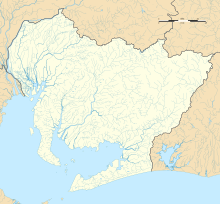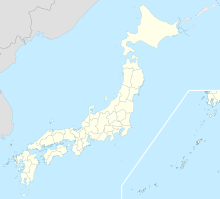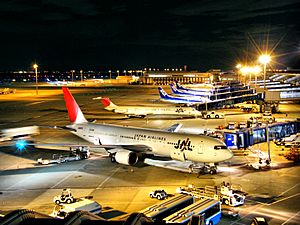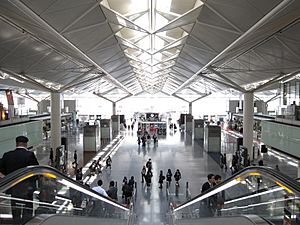Chubu Centrair International Airport facts for kids
Quick facts for kids
Chubu Centrair International Airport
中部国際空港
Chūbu Kokusai Kūkō
|
|||||||||||
|---|---|---|---|---|---|---|---|---|---|---|---|
 |
|||||||||||
| Summary | |||||||||||
| Airport type | Public | ||||||||||
| Owner/Operator | Central Japan International Airport Co., Ltd. (CJIAC) | ||||||||||
| Serves | Chūkyō metropolitan area | ||||||||||
| Location | Tokoname, Aichi, Japan | ||||||||||
| Opened | 17 February 2005 | ||||||||||
| Hub for |
|
||||||||||
| Focus city for |
|
||||||||||
| Elevation AMSL | 12 ft / 4 m | ||||||||||
| Coordinates | 34°51′30″N 136°48′19″E / 34.85833°N 136.80528°E | ||||||||||
| Map | |||||||||||
| Runway | |||||||||||
|
|||||||||||
| Statistics (2018) | |||||||||||
|
|||||||||||
|
Source: Japanese Ministry of Land, Infrastructure, Transport and Tourism
|
|||||||||||
Chubu Centrair International Airport (中部国際空港, Chūbu Kokusai Kūkō) (IATA: NGO, ICAO: RJGG) is a major international airport in Japan. It is built on an artificial island in Ise Bay, near Tokoname City in Aichi Prefecture. This airport is about 35 kilometers (22 miles) south of Nagoya, a big city in central Japan.
Centrair is considered a top-tier airport in Japan. It serves as the main international entry point for the Chubu area, which means "central" Japan. The name "Centrair" is a short way of saying Central Japan International Airport. In 2015, over 10 million people used the airport, making it the 8th busiest in Japan. It also handled a lot of cargo, moving 208,000 tons that year.
Contents
History of Centrair Airport
Chubu Centrair Airport serves the third-largest metropolitan area in Japan, which is around the city of Nagoya. This region is a major hub for manufacturing. Big companies like Toyota Motor Corporation and Mitsubishi Motors have their main offices and factories here.
Local businesses, especially Toyota, wanted a new airport that could handle cargo flights 24 hours a day. So, construction began in August 2000. The project had a budget of about 768 billion Japanese yen (around 5.5 billion Euros or 7.3 billion US dollars). However, the project managers were very efficient and saved almost 100 billion yen!
Chubu Centrair Airport officially opened on February 17, 2005. When it opened, it took over almost all the commercial flights from the older Nagoya Airport (now called Nagoya Airfield). It also helped reduce the amount of cargo handled by airports in Tokyo and Kansai. Because it replaced Nagoya Airport, it kept the same airport code: NGO. The airport opened just in time to welcome visitors for Expo 2005, which was held near Nagoya.
In December 2021, the governor of Aichi Prefecture, Hideaki Omura, announced plans for two new runways at the airport. One 3,290-meter (10,794-foot) runway is planned to be finished by 2027. Another 3,500-meter (11,483-foot) runway will eventually replace the current one.
Changes in Flight Routes
After Centrair opened, some airlines stopped offering certain flights. This often happens if not enough people are flying on those routes. For example, American Airlines stopped its flights to Chicago in 2005. Over the years, other airlines like Malaysia Airlines, Jetstar, and Continental Airlines also paused or ended some of their services from Centrair.
Even major airlines like Japan Airlines and Delta Air Lines (which took over routes from Northwest Airlines) changed their flight plans over time. For instance, Delta stopped its last two routes from Nagoya to Detroit and Honolulu in 2020 due to the COVID-19 pandemic.
Aichi Sky Expo Center
A large exhibition center called "Aichi Sky Expo" opened on the airport island on August 30, 2019. This center has six big exhibition halls, each measuring 10,000 square meters (about 107,639 square feet). It hosts various events, like music festivals.
Airport Terminals
The airport has a main terminal building designed in a "T" shape. The northern part of the terminal is for flights within Japan (domestic flights). The southern part is for international flights to other countries. Each side has its own ticket counters, security checks, and baggage claim areas. International flights also have special areas for immigration and customs.
Passengers arriving at the airport come through the second floor, while those departing leave from the third floor. The ground level is used for airport operations, like maintenance and catering. There are many gates for planes to park, including some for buses that take passengers to planes parked further away. There is also a second terminal, Terminal 2, which is used by budget airlines for both domestic and international flights.
Airport Statistics
Airlines and Destinations
Passenger Flights
| Airlines | Destinations |
|---|---|
| Air Busan | Busan, Seoul–Incheon |
| Air China | Beijing–Capital |
| Air Do | Hakodate, Sapporo–Chitose |
| All Nippon Airways | Fukuoka, Ishigaki, Memanbetsu, Miyako, Tokyo–Narita Seasonal: Asahikawa |
| ANA Wings | Akita, Fukuoka, Kumamoto, Miyazaki, Nagasaki, Naha, Sapporo–Chitose, Sendai, Tokyo–Narita Seasonal: Hakodate |
| Asiana Airlines | Seoul–Incheon |
| Batik Air Malaysia | Kuala Lumpur–International, Taipei–Taoyuan |
| Cathay Pacific | Hong Kong, Taipei–Taoyuan (resumes 29 October 2023) |
| Cebu Pacific | Manila |
| China Airlines | Taipei–Taoyuan |
| China Eastern Airlines | Shanghai–Pudong |
| China Southern Airlines | Dalian |
| Fuji Dream Airlines | Kōchi-Ryoma |
| HK Express | Hong Kong |
| Hong Kong Airlines | Hong Kong |
| Ibex Airlines | Fukuoka, Kagoshima, Kumamoto, Matsuyama, Niigata, Ōita, Sendai |
| Japan Airlines | Honolulu, Sapporo–Chitose, Shanghai–Pudong, Taipei–Taoyuan, Tianjin, Tokyo–Haneda, Tokyo–Narita Seasonal: Obihiro |
| Japan Transocean Air | Naha Seasonal: Ishigaki, Miyako |
| Jeju Air | Seoul–Incheon (begins 15 September 2023) |
| Jetstar Japan | Fukuoka, Kagoshima, Manila, Naha, Sapporo–Chitose |
| Jin Air | Seoul–Incheon (begins 15 September 2023) |
| Juneyao Air | Beijing–Daxing, Shanghai–Pudong (resumes 8 August 2023) |
| Korean Air | Busan, Seoul–Incheon Charter: Muan |
| Oriental Air Bridge | Akita, Miyazaki |
| Peach | Naha, Sapporo–Chitose, Sendai, Taipei–Taoyuan |
| Philippine Airlines | Cebu, Manila |
| Singapore Airlines | Singapore |
| Skymark Airlines | Kagoshima, Naha, Sapporo–Chitose |
| Solaseed Air | Kagoshima, Miyazaki, Naha |
| Spring Airlines | Shanghai–Pudong |
| StarFlyer | Fukuoka |
| Thai Airways International | Bangkok–Suvarnabhumi |
| Tianjin Airlines | Tianjin |
| Tigerair Taiwan | Kaohsiung, Taipei–Taoyuan |
| T'way Air | Jeju |
| United Airlines | Guam |
| VietJet Air | Hanoi |
| Vietnam Airlines | Hanoi, Ho Chi Minh City |
Cargo Flights
| Airlines | Destinations |
|---|---|
| AirBridgeCargo Airlines | Moscow–Sheremetyevo (suspended) |
| ANA Cargo | Hong Kong, Naha |
| Asiana Cargo | Seoul–Incheon |
| DHL Aviation | Anchorage, Cincinnati, Charleston (SC), Everett, Hong Kong, Leipzig/Halle, Seoul–Incheon, Taipei–Taoyuan, Taranto-Grottaglie, Wichita–McConnell |
| National Airlines | Anchorage, Los Angeles |
| Nippon Cargo Airlines | Osaka–Kansai, Tokyo–Narita |
| ULS Cargo | Hong Kong, Istanbul |
Getting To and From the Airport
By Train
The airport has its own train station called Central Japan International Airport Station. It is part of the Meitetsu Airport Line, run by Nagoya Railroad (Meitetsu). The fastest train, called "μSky Limited Express," can take you from the airport to Meitetsu Nagoya Station in just 28 minutes. These special trains travel at a maximum speed of 120 km/h (75 mph). You need to buy an extra ticket for these trains.
Meitetsu Nagoya Station is right next to JR Nagoya Station. From there, you can connect to the Shinkansen (bullet trains) that go to major cities like Tokyo and Osaka. You can also transfer to other local trains and the Nagoya Municipal Subway.
There are ideas to build new train lines to connect Centrair to Nagoya Station, but no construction has started yet.
By Bus
"Centrair Limousine" offers direct bus services. These buses connect the airport to central Nagoya, the Sakae area, and many big hotels. There are also high-speed buses that go to nearby prefectures, like Kyoto, through Mie Prefecture.
By Ferry
You can also take a ferry from the airport. It connects to a passenger terminal in Tsu, and the trip takes about 40 minutes.
By Car
A special toll road connects Centrair Airport to the mainland.
By Bicycle
Bicycles are not allowed on the Centrair Bridge toll road. If you are cycling from the airport, you need to take a Meitetsu local train one stop to Rinkū Tokoname Station. Or, you can take a taxi across the bridge to the Rinkū Interchange.
Shopping and Fun at the Airport
Centrair has a "Sky Town Shopping Center" on its fourth floor, which is open to everyone. It has 61 shops and restaurants. These are divided into two "streets" called Renga-dori and Chochin-yokocho. The shops in Chochin-yokocho are designed to look like traditional Japanese buildings.
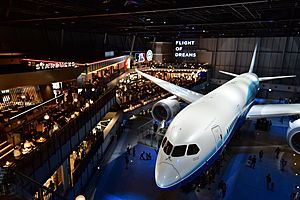
In 2018, a new area called "Flight of Dreams" opened. It's designed to look like Seattle, USA, and its main attraction is the very first Boeing 787 Dreamliner airplane ever built, which is on display there.
Other Facilities
The airport also has the Boeing Dreamlifter Operations Center. This is where parts of the Boeing 787 Dreamliner aircraft made in Japan are stored. They wait here before being flown to the assembly factory in the United States.
Awards and Recognition
Chubu Centrair International Airport has won many awards for its excellent service:
- 2009: Ranked Fourth Best Airport in the World by Airports Council International.
- 2011: Ranked Fifth Best Airport Worldwide and Best Airport by Size for airports with 5 to 15 million passengers.
- 2015: Skytrax named it the "Best Regional Airport 2015" and the "Best Regional Airport – Asia" for the fifth year in a row.
- 2016: Skytrax rated it the "World's Best Regional Airport 2016" and the sixth "Best Airport Worldwide."
- 2017: It became the first airport in the world to get a "5-Star Regional Airport Rating" from Skytrax.
- 2018: For the fourth year in a row, Chubu Centrair won "The World's Best Regional Airport" award (Skytrax). It was also ranked the seventh best airport in the world.
Images for kids
See also
 In Spanish: Aeropuerto Internacional Chūbu Centrair para niños
In Spanish: Aeropuerto Internacional Chūbu Centrair para niños


